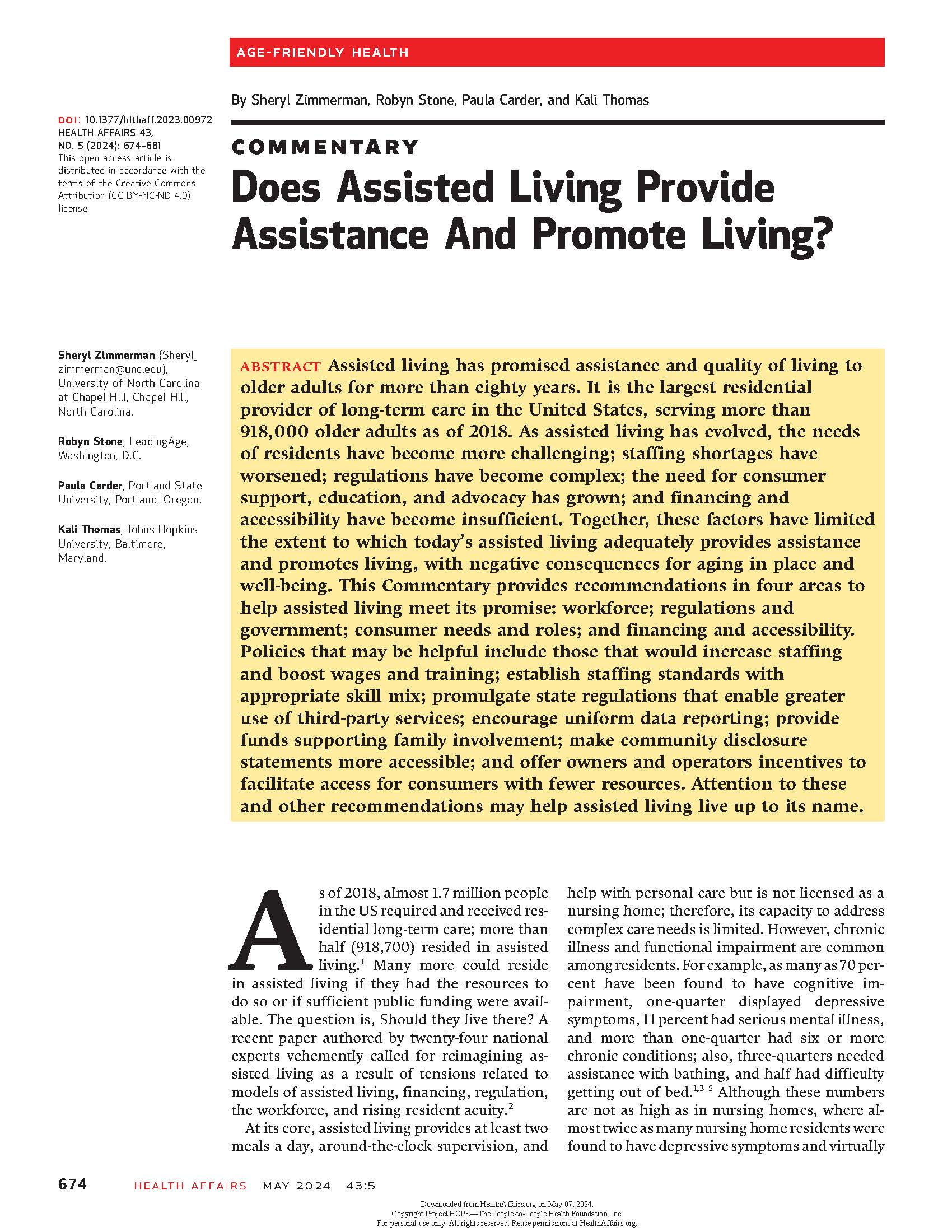Background Residents of assisted living facilities (ALF) transfer to a nursing home when they require a higher level of care, but limited research has examined risk factors for transfer to a nursing home. The aims of this study were to identify (1) baseline factors associated with transfer to a nursing home and (2) time-varying factors […]
Journal of the American Geriatrics Society
Assisted Living Residents with Dementia: Disparities in Mental Health Services Pre and During COVID-19
Assisted Living Residents with Dementia: Disparities in Mental Health Services Pre and During COVID-19
WHAT THIS MEANS FOR YOU: The in-person and telehealth mental health visits of over 102,000 Medicare beneficiaries living with ADRD in 13,400 AL communities were analyzed using CMS data from 2019 and 2020. Use of these services is low in this population, but it was found that Black residents and those with dual Medicare/Medicaid eligibility were significantly less likely to use these services pre-, and during, the COVID-19 pandemic; however, there were no significant differences in visits via telemedicine (vs. in-person) for any racial or ethnic group or dual eligibles.
Do End-of-Life Outcomes Differ by Assisted Living Memory-Care Designation?
Do End-of-Life Outcomes Differ by Assisted Living Memory-Care Designation?
WHAT THIS MEANS FOR YOU: An analysis of 15,152 Medicare beneficiaries with ADRD examined end-of-life outcomes (mortality, hospice use, and number of days receiving hospice in the last month of life) for residents who moved to a large (25+ bed) AL between 2016 and 2018. Residents living in memory care units had a statistically significantly higher rate of mortality, higher hospice use, and more days spent receiving hospice in the last month of life than residents in general AL units.
Hospice Providers Serving Assisted Living Residents: Association of Higher Volume with Lower Quality
Hospice Providers Serving Assisted Living Residents: Association of Higher Volume with Lower Quality
WHAT THIS MEANS FOR YOU: Using Medicare Compare and claims data for over 2800 hospice providers, this analysis found that hospices with higher AL patient volume (i.e., a higher share of their annual patient days were from AL residents) had lower quality ratings from family caregivers in key areas such as pain management, breathing help, emotional support, communication, and family training, even when controlling for profit status and daily patient census. This result indicates that hospice providers who more frequently serve AL resident patients are on average of lower quality, and more research to understand this relationship is recommended.
Worse Quality at For-Profit Assisted Living Facilities in Non-Urban Minnesota
Worse Quality at For-Profit Assisted Living Facilities in Non-Urban Minnesota
WHAT THIS MEANS FOR YOU: This study examined the results of licensure surveys for 292 AL communities in non-urban Minnesota between 2021 and 2023. All AL communities received at least one citation, with an average of 15 citations. Citations were most commonly related to meals (e.g., not providing nutritious meals) and fire protection (e.g., safety and evacuation plans). The average number of citations and resulting fines were higher in for-profit communities than in non-profit/government communities.
Assisted Living or Nursing Home: Who is Moving In?
Assisted Living or Nursing Home: Who is Moving In?
WHAT THIS MEANS FOR YOU: Medicare data examined the characteristics of over 770,000 individuals admitted to assisted living and nursing homes directly from the community between 2017 and 2019. Substantial differences were found between these two groups, including that racial/ethnic minorities, those dually eligible for Medicare and Medicaid, and those having two or more skilled nursing facility stays in the last six months were more likely to be admitted to a nursing home. On the other hand, those who were 75 years or older, male, had one skilled nursing facility or hospital stay, or were Medicare fee-for-service beneficiaries were more likely to be admitted to an assisted living community.
Comparing Quality of Care Outcomes Between Assisted Living and Nursing Homes Before and During the COVID-19 Pandemic
Comparing Quality of Care Outcomes Between Assisted Living and Nursing Homes Before and During the COVID-19 Pandemic
WHAT THIS MEANS FOR YOU: This study used Resident Assessment Instrument data from 2017-2021 in Alberta to examine quality indicator differences between assisted living and nursing home residents (over 2,000 assisted living and about 13,000 nursing home residents per quarter). Antipsychotic use and pain rates were consistently higher in assisted living, while depressive symptoms, dependency, restraint use, delirium, and weight loss were consistently higher in nursing homes. During the COVID-19 pandemic, antipsychotic use increased in both settings, and total dependency increased in assisted living.
Likelihood of Assisted Living Residents Aging in Place as a Factor of Dual Medicare-Medicaid Eligibility at the End of Life
Likelihood of Assisted Living Residents Aging in Place as a Factor of Dual Medicare-Medicaid Eligibility at the End of Life
WHAT THIS MEANS FOR YOU: This study used Medicare enrollment and claims records to examine more than 142,000 AL residents’ ability to stay in their community in the last 30 days of life. Residents who were eligible for both Medicaid and Medicare (dual eligibles) were much less likely than those not eligible for Medicaid to remain in AL in their last 30 days of life or die there. However, this difference varies by state.
Are Online Reviews of Assisted Living Communities Associated with Patient-Centered Outcomes?
Are Online Reviews of Assisted Living Communities Associated with Patient-Centered Outcomes?
WHAT THIS MEANS FOR YOU: Findings from this study suggest that AL’s online reviews may signal quality of care issues, offering consumers information to make more informed decisions in their AL selection, and that reviews may offer insight into residents’ perspectives. However, ratings should not replace, but rather complement, other traditional ways of assessing resident experiences because of rating system limitations. Additionally, ratings may assist providers in making improvements to their ALs based on resident feedback, and function as a data source for policymakers about AL quality of care.
Injury-Related Emergency Department Use among Assisted Living Residents with Alzheimer’s Disease and Related Dementias
Injury-Related Emergency Department Use among Assisted Living Residents with Alzheimer’s Disease and Related Dementias
WHAT THIS MEANS FOR YOU: Using 2018 Medicare data for over 116,000 residents, residents with dementia had a 25% higher risk of going to the emergency room for injuries compared to those without dementia, as well as having a significantly higher chance of being hospitalized for injuries, regardless of whether they lived in general assisted living or memory care.
Psychotropic Medication Prescribing in Assisted Living and Nursing Home Residents with Dementia after the National Partnership
Psychotropic Medication Prescribing in Assisted Living and Nursing Home Residents with Dementia after the National Partnership
WHAT THIS MEANS FOR YOU: Using Medicare data for over 430,000 assisted living and long-stay nursing home residents, prescriptions for antipsychotic drugs decreased in both settings from 2010-2012 (before the National Partnership to Improve Dementia Care in Nursing Homes) to 2012-2017 (post-Partnership). However, assisted living prescribing decreased at a slower rate than nursing homes, meaning that the Partnership likely did not have a measurable impact in assisted living.
Dementia and COVID-19 Infection Control in Assisted Living in Seven States
Dementia and COVID-19 Infection Control in Assisted Living in Seven States
WHAT THIS MEANS FOR YOU: The study examined how 119 assisted living administrators in 7 states implemented COVID-19 infection control practices from July 2020 to September 2021, including the feasibility of select infection control practices. Results indicated that although there were infection control challenges across all community types, dementia-specific communities faced the most difficulties. Less than half of administrators found it feasible to close indoor common areas, and residents, especially in dementia-specific communities, were less likely to wear masks and -wearing and physical distancing.
Psychotropic and Pain Medication Use in Nursing Homes and Assisted Living Facilities during COVID-19
Psychotropic and Pain Medication Use in Nursing Homes and Assisted Living Facilities during COVID-19
WHAT THIS MEANS FOR YOU: This study focused on the potential impact of COVID-19 on the prescription of psychotropic and pain medication in nursing homes and assisted living. Nationally, there was relatively no change in the use of psychotropic and pain medications between pre- and post-COVID periods. However, there was increased use among individuals newly admitted during the pandemic, the cause of which was uncertain.
Post-Acute Care Transitions and Outcomes among Medicare Beneficiaries in Assisted Living Communities
Post-Acute Care Transitions and Outcomes among Medicare Beneficiaries in Assisted Living Communities
WHAT THIS MEANS FOR YOU: Medicare data were used to analyze post-acute care referrals for over 104,000 assisted living residents. The most common referral after hospitalizations was to skilled nursing. Referrals to skilled nursing were associated with a lower likelihood of emergency department visits and hospital readmissions; however, there was higher likelihood of long-term skilled nursing placement and death.
Prevalence and Persistency of Deficiency Citations in Florida Assisted Living Facilities
Prevalence and Persistency of Deficiency Citations in Florida Assisted Living Facilities
WHAT THIS MEANS FOR YOU: State inspection data from 957 large assisted living communities in Florida showed that 87% were cited one or more times from 2012 to 2018. For-profit communities, those with more than 100 beds, and those with a limited mental health license were cited more often. Over 40% of communities were cited in two or more years for the same deficiency category, meaning that repeat citations are common.


